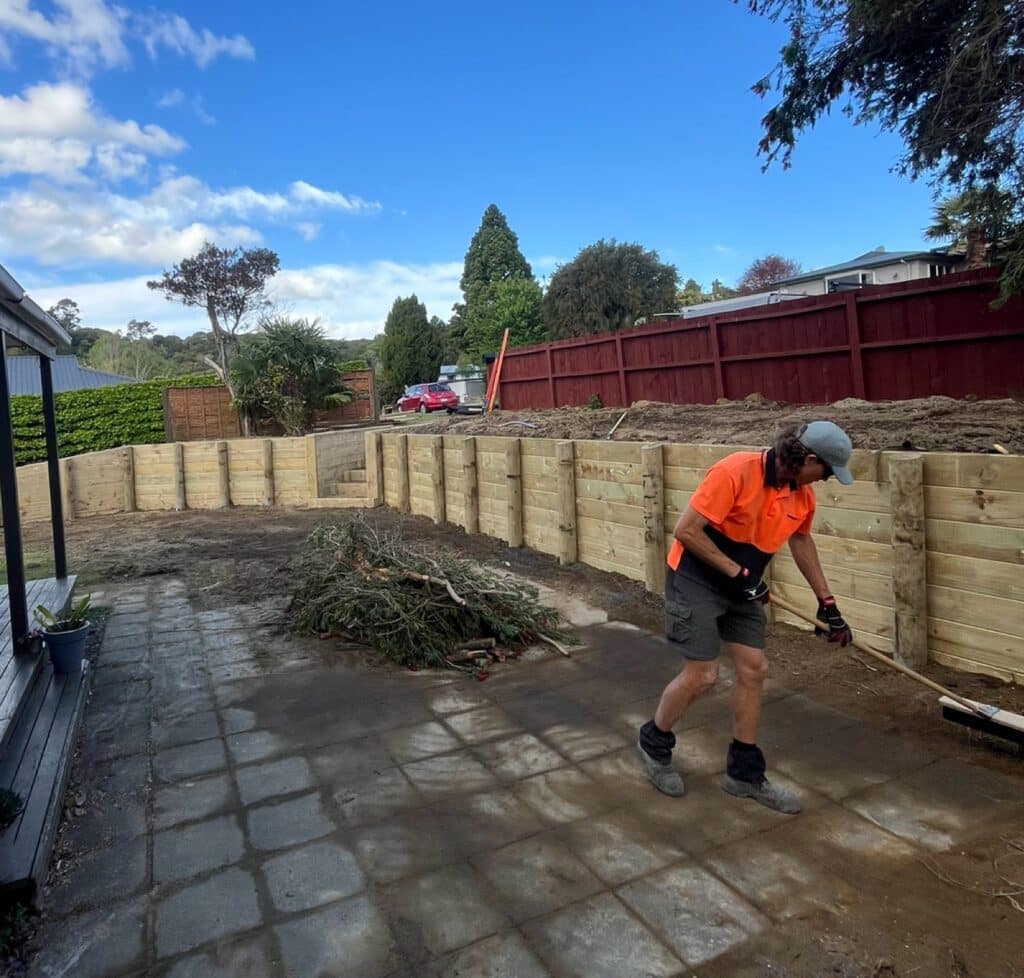Constructing a retaining wall on a steep bank with restricted access requires careful planning, the right materials, and an appropriate construction method. This guide outlines various methods, detailing their pros, cons, and ideal use cases, supported by real-world examples to help you choose the best solution for your project.
Concrete Pumping for Retaining Walls
How It Works:
Concrete pumping uses specialized machinery to transport and place concrete precisely where it’s needed, even in hard-to-reach locations. Boom pumps are often used for high or long reaches, while line pumps handle tighter spaces.
Example Case Study:
A Narrow Backyard with a 3-Meter Drop A homeowner needed a retaining wall for a backyard with steep access only via a side pathway. A line pump was used to deliver the concrete mix directly into the formwork, bypassing obstacles like fences and trees. The result was a strong and durable wall completed in half the time manual methods would have required.
Pros:
- Accurate concrete placement reduces waste and increases efficiency.
- Suitable for remote or steep sites with limited vehicle access.
- Reduced labour needs compared to manual pouring.
Cons:
- Requires specialized equipment and operators.
- Higher upfront cost compared to traditional methods.
Best For:
- High retaining walls.
- Reinforced concrete walls for maximum stability and longevity.
- Steep or inaccessible sites.

Modular Block Retaining Walls
How It Works:
Interlocking concrete blocks are stacked without mortar, creating a stable and visually appealing wall. These blocks can be moved and placed with machinery, making them versatile for challenging sites.
Example Case Study:
Terracing a Sloping Garden A homeowner wanted to create terraced levels for planting on a steep slope. Modular blocks were transported using a small crane, and the dry-stack construction allowed for quick installation. The result was a durable, attractive wall that blended well with the landscaping.
Pros:
- Easy to install without mortar or curing time.
- Wide variety of colors and textures for customization.
- Durable and weather-resistant.
Cons:
- Limited height without reinforcement.
- Requires machinery for transportation on steep sites.
Best For:
- Moderate slopes.
- Projects with aesthetic considerations and quick timelines.
Timber Retaining Walls
How It Works:
Treated timber planks or sleepers are stacked and anchored with vertical posts, creating a simple and cost-effective retaining wall.
Example Case Study:
Retaining Wall for a New Driveway A small driveway required a retaining wall on one side due to a bank. Treated timber sleepers were used, allowing for quick installation and an attractive, natural look and feel..
Pros:
- Affordable and readily available materials.
- Blends well with natural landscapes.
- Simple construction techniques.
Cons:
- Shorter lifespan (50 years) due to rot and insect damage.
- Limited load-bearing capacity.
Best For:
- Low-cost solutions.
- Light-duty residential applications.

Stone Retaining Walls
How It Works:
Stones are carefully stacked (dry-stacked) or bound with mortar to form a durable and visually stunning wall.
Example Case Study:
Preserving a Historical Look A heritage property on a steep hill required a retaining wall that matched the existing stone architecture. Skilled masons built a mortar-bound stone wall, providing both structural stability and a seamless aesthetic.
Pros:
- Timeless appearance that adds value to properties.
- Long-lasting and weather-resistant.
- Can be customized for unique designs.
Cons:
- Expensive materials and skilled labour.
- Heavy stones require equipment for transport in tight spaces.
Best For:
- High-load areas with an emphasis on aesthetics.
- Projects prioritizing durability over cost.
Gabion Retaining Walls
How It Works:
Gabion cages are filled with stones or other materials and stacked to create a strong and permeable wall.
Example Case Study:
Erosion Control for a Streamside Property A property on a steep slope near a stream faced erosion issues during heavy rains. Gabion walls were installed to stabilize the slope, with rock-filled cages allowing water to pass through without undermining the structure.
Pros:
- Effective for erosion control.
- Uses locally sourced materials to reduce costs.
- Minimal maintenance required.
Cons:
- Industrial appearance may not suit all settings.
- Metal cages can corrode over time.
Best For:
- Sites requiring effective drainage and erosion control.
- Large-scale projects with steep slopes.
Factors to Consider When Choosing a Method
- Terrain: Steepness, soil stability, and drainage needs.
- Load Requirements: Heavy structural loads require reinforced solutions.
- Access Challenges: Limited access may necessitate specialized equipment like concrete pumps.
- Aesthetics: Choose materials and methods that align with the property’s style.
- Budget: Weigh initial costs against long-term durability and maintenance.
By carefully evaluating these factors and considering the pros and cons of each method, you can select the ideal solution for your steep bank retaining wall project.











